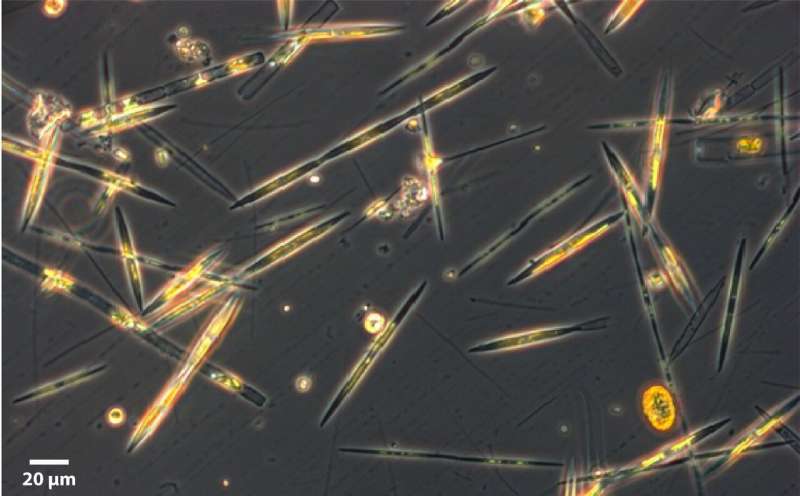Diatoms and other planktonic organisms under the microscope. Credit: MOTax-SZN
Diatoms, single-celled algae typically enshrined in a siliceous cell wall, generally act as opportunistic organisms, reproducing uncontrollably in the presence of favorable conditions, but are also able to make altruistic decisions acting for the good of the community.
A new study, led by Mariella Ferrante of the Zoological Station Anton Dohrn in Naples (SZN), in collaboration with SISSA of Trieste and CEA of Grenoble, focused on the marine diatom Pseudo-nitzschia multistriata, showed that when cells of the opposite mating types meet and are in the right conditions to reproduce sexually, only a small fraction takes part in the sexual event, while the rest of the cells block their own growth limiting their activities and reducing the absorption of nutrients. This phenomenon occurs in conditions of abundance of nutrients, thus representing a paradox for microalgae which usually compete for environmental resources.
Invisible but fundamental
Diatoms are unicellular algae, microscopic and invisible to the naked eye, which live suspended in the waters of our seas, rivers and lakes. These unicellular organisms inhabiting oceanic waters are the base of marine food webs and drive global biogeochemical cycles. Furthermore, through photosynthesis they produce a large portion of the oxygen we breathe.
Dr. Rossella Annunziata of SZN, first author of the work says that "the reason why a big portion of diatoms during a sexual reproduction event choose to reduce nutrient assimilation wasting the opportunity to grow exploiting the available resources lies in the advantage obtained by the daughter cells that will find an environment richer in nutrients which will favor the growth of the new generation, facilitating the development of the community." The coordinator of the study, Dr. Mariella Ferrante of SZN, adds that "it is a very interesting biological model that highlights a fine control of the life cycle in diatoms. This discovery led us to review the current theories on plankton ecology which often take into consideration the sole availability of resources to study the reproductive success of unicellular microalgae. Our results indicate the existence of complex biological mechanisms behind the phenomena involving planktonic organisms."
Studying plankton to understand evolution
Prof. Remo Sanges of SISSA, who coordinated the bioinformatics analysis, comments that "it has been fascinating to observe how unicellular organisms have evolved life strategies which can be considered reminiscent of the well-known parental care of the animal world. These results support the idea that relatively simple organisms are indeed capable of complex behaviors."
One of the goals of evolutionary studies is to understand the selective forces and the demographic mechanisms that drive population dynamics in the face of ecological challenges posed by the interactions with other organisms and by environmental fluctuations. This kind of studies are very important since they contribute to shaping the species ecological niches and to describe and understand the structure of plankton communities.
The research was published in Science Advances.
More information: Rossella Annunziata et al, Trade-off between sex and growth in diatoms: Molecular mechanisms and demographic implications, Science Advances (2022). DOI: 10.1126/sciadv.abj9466
Journal information: Science Advances
Provided by International School of Advanced Studies (SISSA)
























